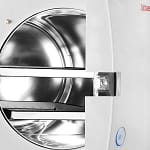Here are a few helpful tips following numerous requests from our customers regarding the maximum load in autoclaves. In order to perform sterilization cycles, there is a maximum weight of instruments and textiles you can place in autoclaves. For an optimal performance, it is recommended to spread the load among all the trays. When you … [Continue Reading]
Do you know when to perform a leak test on your anesthesia machines?
Do you know when it is the best time to perform a leak test on your anesthesia machines? From case to case, leaks can occur on your anesthesia devices. To increase the patient’s as well as your own safety, you should perform a leak test on your veterinary anesthesia machines before each procedure. Unsure if … [Continue Reading]
Feline Inflammatory Bowel Disease: Treating IBD in Cats
Feline inflammatory bowel disease (IBD) is a condition that causes chronic inflammation and irritation of the intestinal tract, most commonly in middle-aged cats. Inflammatory cells infiltrate the walls of the intestinal tract, leading to significant changes in the function of the intestines. Table of Contents Causes of IBD in cats The exact cause of feline … [Continue Reading]
9 essential tips for a healthy autoclave!
You finally got a good quality autoclave to sterilize your veterinary equipment and you want to maximize your investment? You certainly know how to use it, but here are 9 essential tips to maximize its good functioning.
Feline Anesthesia: Protocol, Side Effects and Complications
While feline anesthesia is a routine procedure in many veterinary practices, studies show that the likelihood of anesthetic mortality is higher in cats than it is in dogs. In 2018 the American Association of Feline Practitioners (AAFP) issued updated anesthesia safety guidelines to prevent anesthetic-related mortalities in cats. These guidelines address some of the most … [Continue Reading]
Focal Seizures in Cats: Causes and Treatments
The term seizure is used to describe a self-limiting, asynchronous discharge of neurons within the brain. In humans, seizures are diagnosed on the basis of electroencephalography; in veterinary medicine, however, seizures are typically diagnosed on the basis of clinical appearance. Given that most seizures are witnessed by pet owners, not veterinarians, diagnosing seizures in veterinary … [Continue Reading]
Watch our new robot manufacture a batch of Moduflex Bain circuit adapter!
We are proud to show you our latest technological advancement at Dispomed. The machining team has been working for a while on setting up a robotic arm on one of our milling machines. This ambitious project will allow us to maximize the operating time on this …
Cushing’s Disease in Dogs: Assessing the Efficacy of Dietary Changes and Holistic Treatments
Table of Contents Cushing’s disease, or hyperadrenocorticism, is a common endocrine disease of dogs. It generally affects middle-aged dogs, especially Beagles, Boston Terriers, Boxers, Dachshunds, and Miniature Poodles. There are two types of Cushing’s disease: Pituitary-dependent Cushing’s disease A benign pituitary tumor secretes excessive amounts of adrenocorticotropic hormone (ACTH). This excessive ACTH leads to increased … [Continue Reading]
Feline Panleukopenia: Risk Factors, Prevention and Vaccines
Table of Contents Feline panleukopenia, sometimes known as feline distemper, is a highly fatal viral disease of cats worldwide characterised by gastroenteritis and immunosuppression. In this article, we review risk factors and prevention of feline panleukopenia, with a particular focus on the use of feline panleukopenia vaccines. Feline panleukopenia: symptoms and survival rates Feline panleukopenia … [Continue Reading]
Do you perform enough leak tests on your anesthesia machines?
In this video, see additional leak tests to be performed on your anesthesia machines, which will help you avoid problems during your procedures. Related Products
- « Previous Page
- 1
- …
- 12
- 13
- 14
- 15
- 16
- …
- 22
- Next Page »









